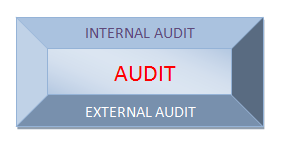ISO Audit
ISO Audit is an assessment carried out to establish the extent to which an organization meets the requirements specified in standards. Audit helps in detecting shortfalls in the procedures and processes and helps attain quality. It is a necessary prerequisite for issuing ISO certification. Based on the party-conducting Audit, it can be classified as Internal Audit and External Audit.

Internal Audit
Audit done by an internal team belonging to the organization is called an Internal Audit. It helps spread quality awareness among the organization members. It prepares them for an external audit. The drawbacks pointed out during internal audit can be corrected before an external audit schedule. It helps maintain quality standards within an organization and provides a way for continual improvement.
External Audit
Audit done by an external independent agency is called an external audit. It is a prerequisite for ISO certification. It assesses the organization against quality standards. It ensures unbiased monitoring of the procedures/processes followed within the organization. It usually issues a certificate accepting the organization as a company of assessed capability which is a witness to the world that this assessed organization satisfies all the requirements of ISO quality standards.
Identification of Non-Conformance
It is an outcome of an Audit either external or internal. Any audit is aimed at identifying these activities that do not satisfy the quality standards directly or indirectly. Such activities are called non-conformances. The non-conformance may be a minor or a major one depending on the degree to which is always the quality system of the company. Too many non-conformances weaken the quality system followed by the organization. Steps should be taken to reduce the number of non-conference.
Corrective and Preventive Action for Effective Quality System
Preventive action is necessary to avoid any failure towards development and maintenance of quality system. Anticipated quality problems should be analyzed for solutions. This prevents quality defects in the organizational system.
When a non-conformance in the existing system is detected, corrective action has to be taken to remove them. This ensures consistence maintenance of quality system within the organization corrective action closes a non-conformance and improves the effectiveness of quality system.
Average Acceleration Calculator
Average acceleration is the object's change in speed for a specific given time period. ...
When an object falls into the ground due to planet's own gravitational force is known a...
In Mathematics, the permutation can be explained as the arrangement of objects in a particular order. It is an ordered...
A rectangle can be explained as a 4-sided quadrilateral which contains equal opposite sides. In a rectangle
A three sided polygon which has three vertices and three angles is called a triangle. Equilateral triangle...






